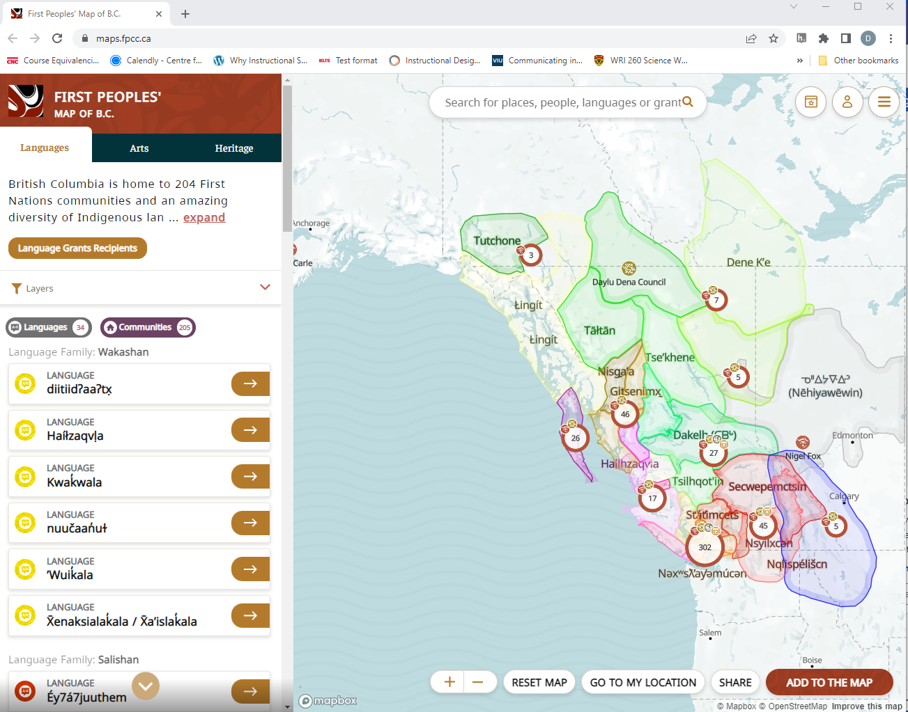Chapter 4: Indigenous Peoples, Communities, and Cultural Safety
4.2 Indigenous Communities in Northern BC and Canada
First Nations are the traditional Indigenous people of the land that is now occupied by modern day Canada. Though First Nations are often described collectively by the Canadian government, they are not one community, but many individual and complex nations. There are 203 First Nations communities just in British Columbia (BC Assembly of First Nations, 2021). According to the last Canadian census in 2016, Indigenous people are 5.9% of British Columbia’s total population, with 63.8% identifying as First Nations; 33% identifying as Métis; and 0.6% identifying as Inuit (Statistics Canada, 2017).
While each First Nations community is distinct, they also have their own internal affiliations, connections, and governance structures. These structures are both traditional and derived from colonial models of governance structures. In the past, First Nations communities in Northern BC were self-governing and oriented toward the good of the collective. Members of different clans worked together as a part of one government. For example, many Carrier, Dene, and Coast Salish communities brought clans together for collective decision making. At the centre of these decisions were potlatch ceremonies which combined governance with spiritual traditions (Gadacz, 2019). Decisions were made together to redistribute wealth, establish status for individuals, groups, and clans, and determine rights related to territory (Gadacz, 2019). However, First Nations governance structure was drastically impacted by the Canadian federal government, who broke up communities into individual and distinct bands, and banned the potlatch. Each band (later First Nation) were funded independently, breaking up the collective decision making of the past. In more recent times, First Nations communities have joined together through tribal councils to engage in some of the collective decision making.
For example, let’s look at how one First Nation community fits into a larger network. The Ulkatcho First Nation has approximately one thousand members, and its traditional territories include the Chilcotin Plateau (Carrier Chilcotin, 2021). The Ulkatcho has a government that is responsible for 22 Indian reserves (Carrier Chilcotin, 2021). Its people are Ulkatchot’en, an ethnic subgroup of Carrier (Ulkatcho First Nation, 2021). Ulkatcho belongs to the Carrier Chilcotin Tribal Council.
The Carrier Chilcotin Tribal Council includes four member First Nations:
- the Lhoosk’uz Dene Nation
- the Lhatako Dene Nation
- Tl’esqox of the Tsilhqot’in
- the Ulkatcho First Nation (Carrier Chilcotin, 2021).
This is one of the two Carrier tribal councils, with the other being the Carrier Sekani. The Carrier Sekani Tribal Council includes six member First Nations including:
- Ts’il Kaz Koh First Nation
- Nadleh Whut’en
- Saik’uz First Nation
- Takla Lake First Nation
- Stellat’en First Nation
- Wet’suwet’en First Nation (Carrier Sekani, 2021).
In addition to these two tribal councils, there are also eight additional independent Carrier Nations (Wikipedia, 2021). More information on specific nations can be found by searching the web.
Today’s Communities
Although still negatively impacted by the past and current colonial policies, Indigenous peoples are working hard to revitalize their languages and cultures. This is why it is important to learn about the Indigenous communities where you live because too often, we only learn about the social devastation and poverty. When the Indigenous people host a cultural event at your school or in your community, be curious to learn about the strength, vitality, and resilience of their cultures.
There are many Indigenous people leading the way and affecting change in their communities whether through government policies, climate change, technical industries, media, and commerce. Indigenous people are at the forefront of conversation for future sustainability methods and in constant relations to all things governing the communities in which we live.
Here are some examples of entrepreneurs and leaders in Canada and what they are doing:
- Meet the Voices of Youth Indigenous Leaders 2022 Participants
- Celebrating International Women’s Day with Zoë Craig-Sparrow ’15
- Indigenous-owned Businesses to Support
Things You Can Do to Learn Mo re about Indigenous Communities Near You
Individually
- Start with some online research. Many communities maintain their own websites with events, resources, and history of their people. You can also use the Internet to learn more about the protocols and etiquette appropriate for visiting and engaging with Indigenous communities.
- Attend a public event. Visiting a local community can be a great way to build relationships with local Indigenous communities. Be sure to be respectful and follow appropriate protocols. Not sure what to do? Take the advice of Indigenous Corporate Training (2021), “when in doubt about what to do, ask the host or a friend of the community to explain the ceremony’s participation process. If all else fails, follow the lead of the people in front of you” (28).
At School
- Visit the Indigenous or Aboriginal Resource Centre on campus. You can learn about the programs, events and resources put on by the department. These centres also often run local events, so you can visit the office or website to find out what events are open to the public.
- Engage with an Elder in Residence, Visiting Elder, Indigenous/Aboriginal Support Worker, Advisor or Liaison. Many campuses engage in programs to bring Indigenous Elders to campus. These staff maintain office hours, so you can schedule an appointment.
- Take a class in an Indigenous Studies or Aboriginal Studies program. Many colleges and universities have degree programs and electives that can immerse you in language and culture of local First Nations communities.
Activity
Do you live in British Columbia? Take a look at the First Peoples’ Map of BC. It shows all of the different First Nations communities. Which ones are near you? What languages do they speak? What art and heritage can you learn about? Use this map as a starting point to learn more about the cultures that shape the place where you live.

Media Attributions
- “Figure 4.1 First Peoples’ Map of BC” © First Peoples’ Heritage Language & Culture Council is for personal, non-commercial use only.

